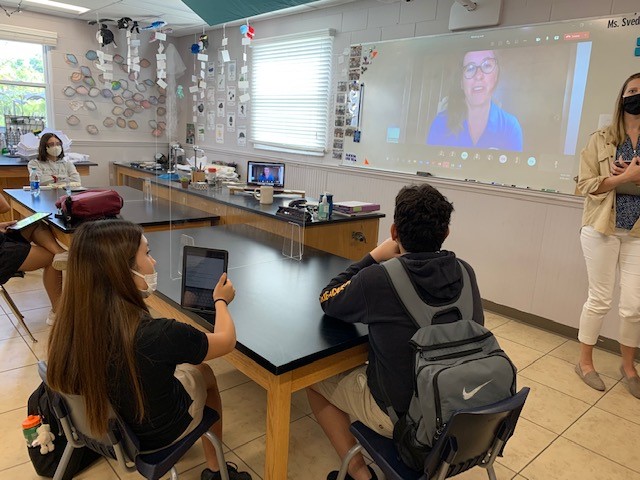Marine Biology Class Focuses on Manatees
Living in Florida, nearly everyone is familiar with manatees – slow-moving marine mammals that are often found in rivers, estuaries, canals, and coastal areas where seagrass or freshwater vegetation flourish. Because they don’t like cold water, Florida is their home in winter months as our waters in places like the Crystal River, stay around 72 degrees all year long.
Ms. Alissa Svedberg’s marine biology classes had the good fortune to hear from Andrea Swinehart, an animal keeper at Disney’s Animal Kingdom and volunteer for the Save the Manatee Club, who joined the class virtually to give a presentation about the manatee, raise awareness about this friendly creature and answer students’ questions.
“It was wonderful getting to partner with the Save the Manatee Club to have Andrea Swinehart join our classes virtually to discuss one of Florida’s most popular marine mammals!” said Ms. Svedberg. “Having experts in their fields speak to students is exciting to showcase possibilities of how MVA students can build upon their passions. I join Ms. Swinehart in encouraging passionate students to find volunteer and internship opportunities with fantastic organizations such as Save the Manatee.”
Some interesting facts that Ms. Swinehart shared about the manatee include the fact that they are closely related to elephants, can hold their breath up to 20 minutes, can weight up to a ton with babies that weigh in at 60 pounds at birth, and they are vegetarians. There are approximately 5,733 manatees as of January 2019, and are currently on the threatened animal list, downgraded from endangered in 2017. The protection has helped increase awareness and improved the number of manatees, but we need to remain aware of their plight because nearly 23 percent of manatee deaths are caused by humans in boats.
Manatees tend to stay near the surface of the water as they breathe air every three to five minutes between feasting on seagrass and vegetation. Boaters not paying close attention to where they are going or the speed at which they navigate shallower waterways, can quickly and easily hit a manatee that doesn’t have the speed or agility of a dolphin or seal to escape a fast-moving boat. Sadly, scars on a manatee’s back are often identifying marks that allow scientists such as Ms. Swinehart, to count and track the mammals.
Through the work of organization such as Save the Manatee Club, these animals can be protected and awareness raised manatee deaths caused by humans can be reduced and recovery of the species – to ultimately be taken off the endangered species list – be realized.






